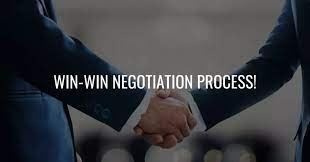
Dear Readers, In this Part we will Discuss about ” The Compromise Solution” . What is it ? Let’s talk about it.
Unfortunately, many Negotiators think that compromise is synonymous with collaboration. It is not. By it’s very definition, compromise is synonymous agreement in which each side gives up something it really wanted. It is an outcome where no one fully meets his/her needs.
The strategy of compromise rests on the faulty premise that your needs and mine are always in opposition. And so it is never possible for mutual satisfaction to be achieved.
Acting upon this assumption, each of us starts out making an outlandish demand, so that he can ultimately have room to make concessions.
When the pressure builds on both of us to lay aside our differences for the sake of society as a whole, we compromise at a midpoint between our extreme positions. This solution is accepted to avoid a deadlock, but neither of us is really satisfied.
Our needs frustrated, we find some solace in reciting old bromides and clichés: ” Half a Loaf is better than none,” or ” Give a little, get a little,” or ” A good Negotiation outcome is one where both sides are somewhat dissatisfied.”
Needless to say, neither of feels much obligation to support this arrangement which has not given either side what it really wanted.
If we were to apply “The compromise Formula” literally to some of life’s Negotiation dilemmas the solutions would be ridiculous.
Let me show you what I mean with the following simple Anecdotes:
Vignette 1
2 Graduate students from Seattle, Washington, decide to spend their winter holiday together. He wants to go to Las Vegas, and her preference is Taos, New Mexico. All we know is that each of them has independently arrived at their conclusion.
Let’s assume that we can use only the 2 Geographic Alternatives in finding a middle-ground solution. If we were to methodically apply the compromise formula the couple would spend their holiday in the vicinity of Polacca on the Hopi Indian reservation in Northeast Arizona.
Obviously, I have exaggerated to make my point. By now you realize that this couple shared Information, Experience, Assumptions, and Expectations, a location could be selected that would result in a mutually rewarding trip.
For the sake of argument, if his needs are gambling and big-name entertainment and her needs are downhill skilling and fresh air, options exist ( such as Lake Tahoe and Squaw Valley) for both of them to get exactly what they want.
Vignette 2Recently, I ran across an Interesting story dealing with compromise. It was told to me by a friend, who is affectionately known as Big Buddha, ” The Enlightened One“.
He goes by this moniker because he once left his wife and infant son to devote himself wholeheartedly to the search for truth. In his case, the noble quest lasted 22 hours, but the nickname remained.
Big Buddah recounted a dispute that his 2 Teenage Sons had at the conclusion of a Sunday Family dinner. the object of their conflict was a left over baked Idaho Potato — not a very big issue in the scheme of things.
Each son contended that his claim was superior, and the disagreement intensified.
Playing the role of Patriarch, but without getting any information, my friend made the decision for them. In the Buddhist Tradition of “Middle Way,” he cut the potato in half and divided it between the sibling rivals.
Satisfied with his solution, he adjourned to the living room for serenity of soul — or Nirvana via TV.
Later that evening, Big Buddha was advised that his “Perfect Compromise” had to be renegotiated. It seemed that one son wanted only the skin, whereas desired merely the soft inside of the potato.
Obviously, their needs were not in opposition, and the best solution was not a symmetrical compromise.
Well, Dear Readers in Next Part we will discuss another Vignette that will be discussed in detail so you can understand much better.
“Vignette 3”
Do not Forget to Follow my Website for Future Updates.
One thought on “More on the Win-Win Technique | Dealing with Opposition ( Part 6 )”